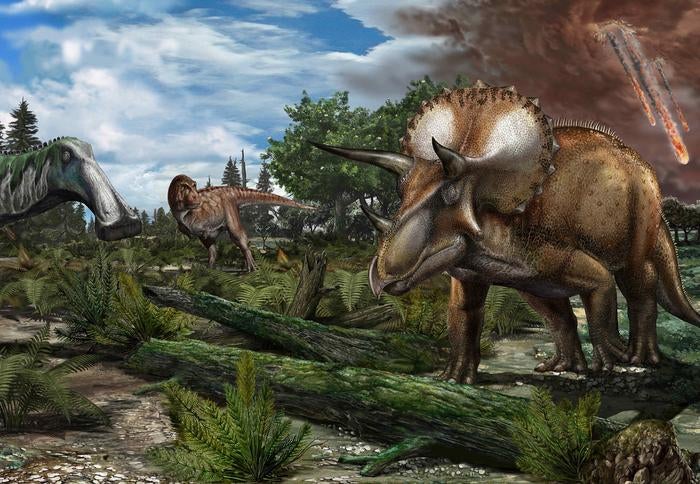ARTICLE AD BOX
There might still be dinosaurs living on Earth today — if not for the giant asteroid.
It’s a long-debated issue, but now researchers say the idea Dinosaurs were in decline before the Chicxulub asteroid struck 66 million years ago could be due to fossil collection practices. Not from an actual decline in population before the extinction event. Previous research had found climate change could be the cause of the initial decline.
“We analyzed the fossil record and found that the quality of the record of four groups of dinosaur (clades) gets worse during the final six million years prior to the asteroid. The probability of finding dinosaur fossils decreases, while the likelihood of dinosaurs having lived in these areas at the time is stable,” said Dr. Chris Dean, a professor at University College London, said in a statement. “This shows we can’t take the fossil record at face value.”
Dean was the lead author of the research, which was published earlier this month in the journal Current Biology.

To reach these conclusions, the authors examined the historical timeline of more than 8,000 fossils in the 18 million years leading up to the asteroid impact at the end of the Cretaceous period. Signs of decline in the years leading up to the impact were due to fossils being less likely to be discovered, they asserted. That’s primarily because there are fewer locations with exposed and accessible rock from that time.
They focused on four groups that included the armored Ankylosaurus, the popular Triceratops, the duckbilled Edmontosaurus and the king, Tyrannosaurus Rex. Using a statistical method to assess how likely a species is to inhabit a particular area, they estimated how much of North America the dinosaurs likely occupied at four different times in those 18 million years.
The researchers said that the proportion of land the dinosaur groups likely occupied remained constant overall. That suggests their potential habitat area remained stable and the risk of extinction stayed low.
“Half the fossils we have from this time were found in North America. Our findings hint that, in this region at least, dinosaurs may have been doing better than previously suggested in the lead-up to the asteroid impact, potentially with a higher diversity of species than we see in the raw rock record,” Dean explained.

Researchers also estimated the likelihood of the four dinosaur types being detected in each area, basing that on how much land is accessible to researchers, how much rock is exposed and how many times the researchers had attempted to find fossils from that area. The likelihood of detection declined over the years they examined. Triceratops and its group of related dinosaurs were more likely to be detected due to them favoring green plains when the habitat became the main type of environment being maintained.
“In this study, we show that this apparent decline is more likely a result of a reduced sampling window, caused by geological changes in these terminal Mesozoic fossil-bearing layers - driven by processes such as tectonics, mountain uplift, and sea-level retreat — rather than genuine fluctuations in biodiversity,” co-author Dr. Alessandro Chiarenza added.
“Dinosaurs were probably not inevitably doomed to extinction at the end of the Mesozoic. If it weren’t for that asteroid, they might still share this planet with mammals, lizards, and their surviving descendants: birds,” he said.









 English (US) ·
English (US) ·